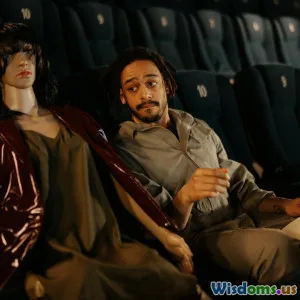
Film and Identity: A Cultural Exploration
8 min read Explore how film shapes and reflects identity, revealing cultural narratives that define who we are globally. (0 Reviews)
Film and Identity: A Cultural Exploration
Film has long been a powerful medium not only for entertainment but also for storytelling that reflects and shapes our identities. At its core, cinema acts as a cultural mirror, reflecting the beliefs, values, and struggles of the communities that produce and consume it. But beyond mere reflection, films often actively participate in forging identity—whether personal, social, or national. This article explores the dynamic relationship between film and identity, highlighting how movies contribute to cultural understanding and expression in diverse societies.
The Cinema as a Cultural Mirror
Films capture the zeitgeist — the spirit of a particular time and place — by narrating stories that resonate with their audiences' lived experiences. Whether it is the Italian neorealist classics like Bicycle Thieves (1948) reflecting post-war hardship, or the vibrant celebration of Afro-Caribbean culture in Half Moon (2006), cinema carefully documents cultural nuance.
Movies provide a lens through which viewers can witness traditions, dialects, rituals, and social customs. They preserve identity markers that might otherwise be marginalized in a fast-globalizing world. For example, South Korean cinema’s international rise, showcasing films like Parasite (2019), has introduced global audiences to complex class dynamics and societal pressures unique to Korea, offering both local identity affirmation and international cultural dialogue.
Film as an Agent of Identity Formation
Films do not merely mirror culture; they also have the power to shape and influence identity formation. For many individuals, especially in childhood and adolescence, watching films allows experimentation with different cultural roles, values, and behaviors.
Consider the impact of Hollywood on global youth. Characters ranging from superheroes to down-to-earth heroines provide role models, embedding ideals about courage, justice, or independence. For marginalized communities, cinema can be a space to see themselves positively represented, which is known to bolster self-esteem and cultural pride.
Take the example of Moonlight (2016), a landmark film exploring Black gay identity in a nuanced and empathetic way. Before this film, mainstream cinema offered few complex portrayals of intersectional identities like those of LGBTQ+ people of color. The success of Moonlight sparked vital conversations on belonging and acceptance, extending beyond the screen into real societal change.
National Identity and Cinematic Storytelling
Many nations have used cinema as a tool to foster a cohesive national identity. State support for films that promote historical myths, cultural traditions, or political ideals often comes at the intersection of art and propaganda.
India’s prolific film industry, Bollywood, famously reinforces elements of Indian culture and identity through music, family values, and mythology. Movies like Lagaan (2001) showcase themes of resistance and unity during colonial times, directly linking shared history with modern patriotism.
Similarly, indigenous film movements worldwide seek to reclaim identity and narrative sovereignty. Films crafted by indigenous filmmakers often correct misconceptions and challenge stereotypes propagated by dominant cultures. For instance, Atanarjuat: The Fast Runner (2001), an Inuit production, not only tells a traditional legend but re-centers indigenous voices as cultural curators for their community’s identity.
Globalization, Hybridity, and Identity Fluidity
Globalization challenges static concepts of identity, and films illustrate the fluidity caused by cross-cultural exchange. Transnational cinema reveals hybrid identities blending diverse influences. Immigrant narratives like The Farewell (2019) portray the tension of balancing ethnic heritage with new cultural contexts.
Mass media and technological advances increase accessibility to a variety of films from around the world, enabling people to encounter narratives beyond their immediate environment. This exposure fosters empathy and disrupts ethnocentric perspectives by highlighting shared human experiences despite cultural differences.
Moreover, diasporic filmmakers use cinema to negotiate dual or multiple identities, providing complex portraits that confront issues of belonging and alienation in host societies. This cinematic hybridity helps audiences understand identity as dynamic and multifaceted instead of fixed or monolithic.
Representation and Inclusion: Issues of Power and Voice
One of the most crucial aspects of film’s relation to identity is whose stories get told and how. Historically, film industries worldwide have marginalized certain groups by omission or stereotype, distorting identity representation.
Modern movements demand greater diversity and inclusion in front of and behind the camera. The increase in films by women, LGBTQ+ creators, and ethnic minorities is gradually reshaping cinematic portrayals to be more authentic and expansive.
A striking example is the growing success of queer cinema, which battles invisibility and misrepresentation. Festivals like Outfest elevate LGBTQ+ voices, allowing storytelling that affirms identity and builds community solidarity.
The ongoing call for intersectional representation shows how film industries influence societal attitudes and reinforce or dismantle systemic biases. Thus, film is not merely cultural reflection but an arena for social justice and identity politics.
Conclusion: Cinema’s Enduring Impact on Identity
Films serve as vital cultural artifacts that both preserve and transform identity. They communicate traditions, question norms, and influence how individuals and groups see themselves and others.
As society evolves through globalization and demographic shifts, cinema continues to negotiate and portray new forms of identity—where hybridity, inclusion, and authenticity become central themes. This ongoing dialogue between film and identity enriches cultural understanding and empowers voices that have long been unheard.
Ultimately, engaging critically with film invites audiences to reflect on their own identities and embrace the diversity that defines our global tapestry. In a world shaped by images and stories, cinema remains a profound cultural force—one that educates, inspires, and connects human experiences across boundaries.
References and Further Reading:
- Hamid Naficy, An Accented Cinema: Exilic and Diasporic Filmmaking (Princeton University Press, 2001).
- Stuart Hall, Cultural Identity and Diaspora in Identity: Community, Culture, Difference (Lawrence and Wishart, 1990).
- Patricia White, Women’s Cinema, World Cinema: Projecting Contemporary Feminisms (Duke University Press, 2015).
- Silvia Pedraza, Circuits of Power: Community, Culture, and Citizenship in Mexico (University of Notre Dame Press, 2018).
Rate the Post
User Reviews
Popular Posts




















